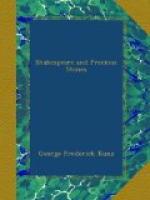If heaven would make me such
another world,
Of one entire and perfect chrysolite!
Othello, Act
v, sc. 2.
“Tragedies”, p. 337,
col. A, line 5.
Chrysolite (peridot, or olivine) was regarded in Shakespeare’s time and earlier as of exceptional rarity. The fine peridots of the Chapel of the Three Kings in Cologne Cathedral were believed to be emeralds of extraordinary size and were once valued at $15,000,000, although they are really worth barely $100,000; some of them are more than an inch in diameter. Whence they came is uncertain, but it is probable that they were brought from the East at some time during the Crusades. Indeed the origin of the fine peridots of the Middle Ages is shrouded in mystery; they are, however, believed to have been found in one or more of the islands in the Red Sea. In our day a number of specimens have been discovered on the small island of St. John in that sea; the deposit here is a jealously-guarded monopoly of the Egyptian Government. Peridots have also been found at Spyrget Island, in the Arabian Gulf. The most remarkable source of gem-material of this stone is meteoric, a few gems weighing as much as a carat each having been cut out of some yellowish-green peridot obtained by the writer from the meteoric iron of Glorieta Mountain, New Mexico.
That a turquoise, presumably set in a ring, was given to Shylock by Leah before their marriage, perhaps at their betrothal, is all that Shakespeare has found occasion to write of this pretty stone, one of the earliest used for adornment in the world’s history, as the great mines of Nishapur, in Persia, and those of the Sinai Peninsula were worked at a very early time, the latter by the Egyptians as far back as 4000 B.C. With the opal, the poet has seized upon its most characteristic quality, its changeableness of hue, where he says in Twelfth Night (Act ii, sc. 4): “Thy mind is a very opal”.
A luminous ring is poetically described in one of Shakespeare’s earliest plays, Titus Andronicus, written in or about 1590. The lines referring to the ring are highly expressive. After the murder of Bassianus, Martius searches in the depths of a dark pit for the dead body, and suddenly cries out to his companion Quintus that he has discovered the bloody corpse. As the interior of the pit is pitch dark, Quintus can scarcely believe what he hears, and he asks Martius how the latter could possibly see what he has described. The answer is given in the following lines:
Upon his bloody finger he doth
wear
A precious ring, that lightens all the hole,
Which, like a taper in some monument,
Doth shine upon the dead man’s earthy
cheeks,
And shows the ragged entrails of the pit.
Titus Andronicus, Act
ii, sc. 3.
First Folio, “Tragedies”, p. 38, col.
B, lines 53-57.
This certainly was suggested by the common belief in naturally luminous stones, a belief partly due to a superstitious explanation of the ruddy brilliancy of rubies and garnets as resulting from a hidden fire in the stone, and partly, perhaps, to the occasional observation of the phenomena of phosphorescence or fluorescence in certain precious stones.




